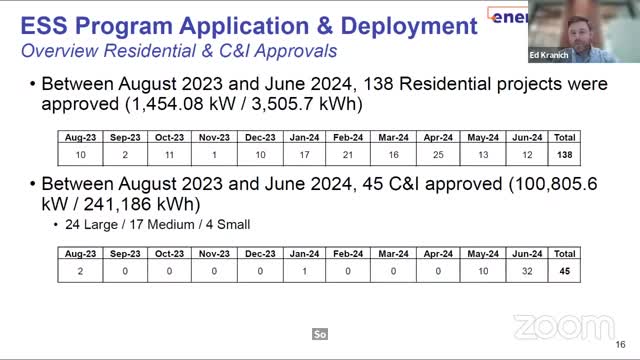Surge in Solar Applications Signals Market Recovery
August 07, 2024 | Public Utilities Regulatory Authority, Departments and Agencies, Organizations, Executive, Connecticut
This article was created by AI summarizing key points discussed. AI makes mistakes, so for full details and context, please refer to the video of the full meeting. Please report any errors so we can fix them. Report an error »

In a recent government meeting, officials provided an update on residential and commercial project approvals over the past year, revealing a mixed landscape for energy applications. The volume of residential applications remained low, largely due to stakeholders anticipating an increase in incentive levels, which ultimately occurred in January 2024. Following this, application rates surged, resulting in 138 new residential applications and the approval of nearly 1.5 megawatts of new capacity.
Conversely, the commercial and industrial (CNI) sector saw a significant slowdown, with application volumes nearly nonexistent until a recent uptick in May and June. This was attributed to developers batching their projects and the announcement of a pause on CNI applications, which led to a rush of submissions before the deadline. In total, 42 new CNI applications were approved during this period, contributing to a three-year target of 100 megawatts, with a total capacity of over 240 megawatts achieved.
Challenges persist in the residential sector, particularly regarding the appeal of energy storage solutions compared to solar energy. Despite identifying 21 underserved residential projects, there have been no applications from low-income customers since August 2023, raising concerns about accessibility to incentives for this demographic.
The meeting also highlighted a surge in contractor enrollments, with 24 new contractors joining the program in the past year, primarily driven by the impending pause on CNI applications. The average time from application submission to approval has improved, now averaging around 30 days, with a median of just 13 days for new contractors.
In terms of technology, the approval process for new energy technologies has been streamlined, ensuring that only fully integrated systems are eligible for incentives. Notable new entrants include Tesla and several battery manufacturers aiming to penetrate the Connecticut market.
Financially, the Green Bank issued nearly $958,000 in upfront incentive payments for residential projects and $187,800 for CNI projects from August 2023 to July 2024. However, only three CNI projects have been completed, indicating a lag in project execution despite approvals.
The meeting concluded with discussions on inspection rates, which have dropped significantly since inspections became optional, and ongoing efforts to enhance marketing and outreach strategies to boost participation in energy programs. Overall, while there are signs of recovery and growth in certain areas, significant challenges remain in ensuring equitable access to energy incentives and improving project completion rates.
Conversely, the commercial and industrial (CNI) sector saw a significant slowdown, with application volumes nearly nonexistent until a recent uptick in May and June. This was attributed to developers batching their projects and the announcement of a pause on CNI applications, which led to a rush of submissions before the deadline. In total, 42 new CNI applications were approved during this period, contributing to a three-year target of 100 megawatts, with a total capacity of over 240 megawatts achieved.
Challenges persist in the residential sector, particularly regarding the appeal of energy storage solutions compared to solar energy. Despite identifying 21 underserved residential projects, there have been no applications from low-income customers since August 2023, raising concerns about accessibility to incentives for this demographic.
The meeting also highlighted a surge in contractor enrollments, with 24 new contractors joining the program in the past year, primarily driven by the impending pause on CNI applications. The average time from application submission to approval has improved, now averaging around 30 days, with a median of just 13 days for new contractors.
In terms of technology, the approval process for new energy technologies has been streamlined, ensuring that only fully integrated systems are eligible for incentives. Notable new entrants include Tesla and several battery manufacturers aiming to penetrate the Connecticut market.
Financially, the Green Bank issued nearly $958,000 in upfront incentive payments for residential projects and $187,800 for CNI projects from August 2023 to July 2024. However, only three CNI projects have been completed, indicating a lag in project execution despite approvals.
The meeting concluded with discussions on inspection rates, which have dropped significantly since inspections became optional, and ongoing efforts to enhance marketing and outreach strategies to boost participation in energy programs. Overall, while there are signs of recovery and growth in certain areas, significant challenges remain in ensuring equitable access to energy incentives and improving project completion rates.
View full meeting
This article is based on a recent meeting—watch the full video and explore the complete transcript for deeper insights into the discussion.
View full meeting
